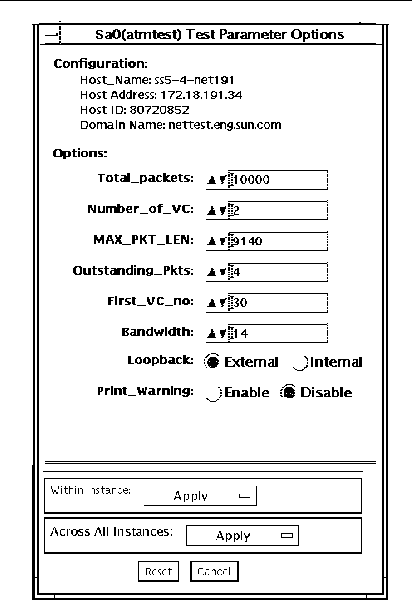| SunVTS 6.2 Test Reference Manual for SPARC Platforms
|
   
|
SunATM Adapter Test (atmtest)
|
atmtest Description
The atmtest checks the functionality of the SunATM 155 and SunATM 622 SBus and PCI bus adapters.
155 and SunATM 622 SBus and PCI bus adapters.
It runs only in loopback (external or internal) mode. The asynchronous transfer mode (ATM) adapter, and ATM device driver must be present. To run the atmtest in external loopback mode, a loopback connector must be attached to the ATM adapter. The internal loopback mode does not require a loopback connector.
atmtest uses DLPI RAW mode to talk to the device driver. The test establishes a virtual circuit (VC) to send a message, receive a message, and compare messages. If the messages do not match, or if the message is out of sequence, atmtest displays an error message.
Using a random number generator, atmtest sends data into a data buffer and then sends each message from a different starting point. This assures that no two consecutive messages are the same.
atmtest can test more than one virtual circuit. Using more virtual circuits increases the stress level of the test. atmtest automatically selects the virtual circuit number that is unique to the test.
atmtest is nonscalable because it provides multiple virtual circuits to be tested by a single instance.
atmtest Test Requirements
atmtest can only be selected when the Intervention mode is enabled, since it requires a loopback connector for external loopback testing. While Intervention mode is enabled, atmtest and nettest are both available as default selections However, you must deselect nettest when testing the ATM device.
Shutdown the ATM interface to make sure that the interface is in offline mode before running atmtest.
|
Note - Do not run nettest while running atmtest.
|
|
Note - The external optical loopback test requires a 62.5 micron cable.
|
atmtest Options
To reach the following dialog box, right-click on the test name in the System Map and select Test Parameter Options. If you do not see this test in the System Map, you might need to expand the collapsed groups, or your system might not include the device appropriate to this test. Refer to the SunVTS User's Guide for more details.
FIGURE 2-1 atmtest Test Parameter Options Dialog Box

TABLE 2-1 atmtest Options
|
Options
|
Description
|
|
Configuration
|
The post address, host ID, and domain name of the system being tested.
|
|
Total packets
|
The total number of packets sent. The default number of packets sent is 10000.
|
|
Number of VC
|
The default number of virtual circuits is 2. The atmtest uses these two virtual circuits to send out messages simultaneously. The message is received in sending order.
|
|
MAX-PKG-LEN
|
The maximum packet length to be used by the test to send out the data. The default number is 9140.
|
|
Outstanding-pkts
|
The maximum number of outstanding packets. atmtest stops sending messages when the outstanding packet count is more than the number of packets this field specifies.
|
|
First-VC-no
|
Enables the user to set up the starting virtual circuit number to be used for each atmtest instance. atmtest can automatically avoid virtual circuit numbers that have already been used.
|
|
Bandwidth
|
Enables the user to select different bandwidths to test. The default number is 14.
|
|
Loopback
|
Enables the user to select either the external loopback field or internal loopback field. The default selection is the external loopback field. A loopback connector is only needed for external loopback testing.
|
|
Print Warning
|
Disabled by default. Click Enable to see warning errors, such as retry on timeout.
|
atmtest Test Modes
TABLE 2-2 atmtest Supported Test Modes
|
Test Mode
|
Description
|
|
Functional
|
Runs the full set of tests.
|
atmtest Command-Line Syntax
/opt/SUNWvts/bin/atmtest standard-arguments,-o dev=device,tpkts=n,nv=n,ml=n,bw=n,opkts=n| warn|ld|sd|sl|nc|ns,vcf=n
TABLE 2-3 atmtest Command-Line Syntax
|
Argument
|
Description
|
|
dev=device
|
Specifies the device name to be tested, such as ba0 or sa0.
|
|
tpkts=n
|
Specifies the number of packets to loopback, -1 for continuous [1...2147483647, -1].
|
|
nv=num-vc
|
Specifies the number of simultaneous virtual circuits to be tested.
|
|
ml=max-len
|
Specifies the maximum length of the random packet.
|
|
bw=bandwidth
|
Specifies the bandwidth in Mbyte/s of a virtual circuit.
|
|
opkts=n
|
Specifies the number of packets for each virtual circuit that can be transmitted without receiving a corresponding packet.
|
|
warn
|
When enabled, prints warning messages.
|
|
ld
|
The internal loopback mode is selected.
|
|
sd
|
Changes the payload data to static instead of random.
|
|
sl
|
Changes all packets to their maximum length.
|
|
nc
|
Instructs the test not to check the receive payload (improves throughput).
|
|
ns
|
Instructs the test not to exit on a packet reception failure.
|
|
vcf=n
|
Specifies the first virtual circuit number used.
|
| SunVTS 6.2 Test Reference Manual for SPARC Platforms
|
819-6455-10
|
   
|
Copyright © 2006, Sun Microsystems, Inc. All Rights Reserved.
 155 and SunATM 622 SBus and PCI bus adapters.
155 and SunATM 622 SBus and PCI bus adapters.
